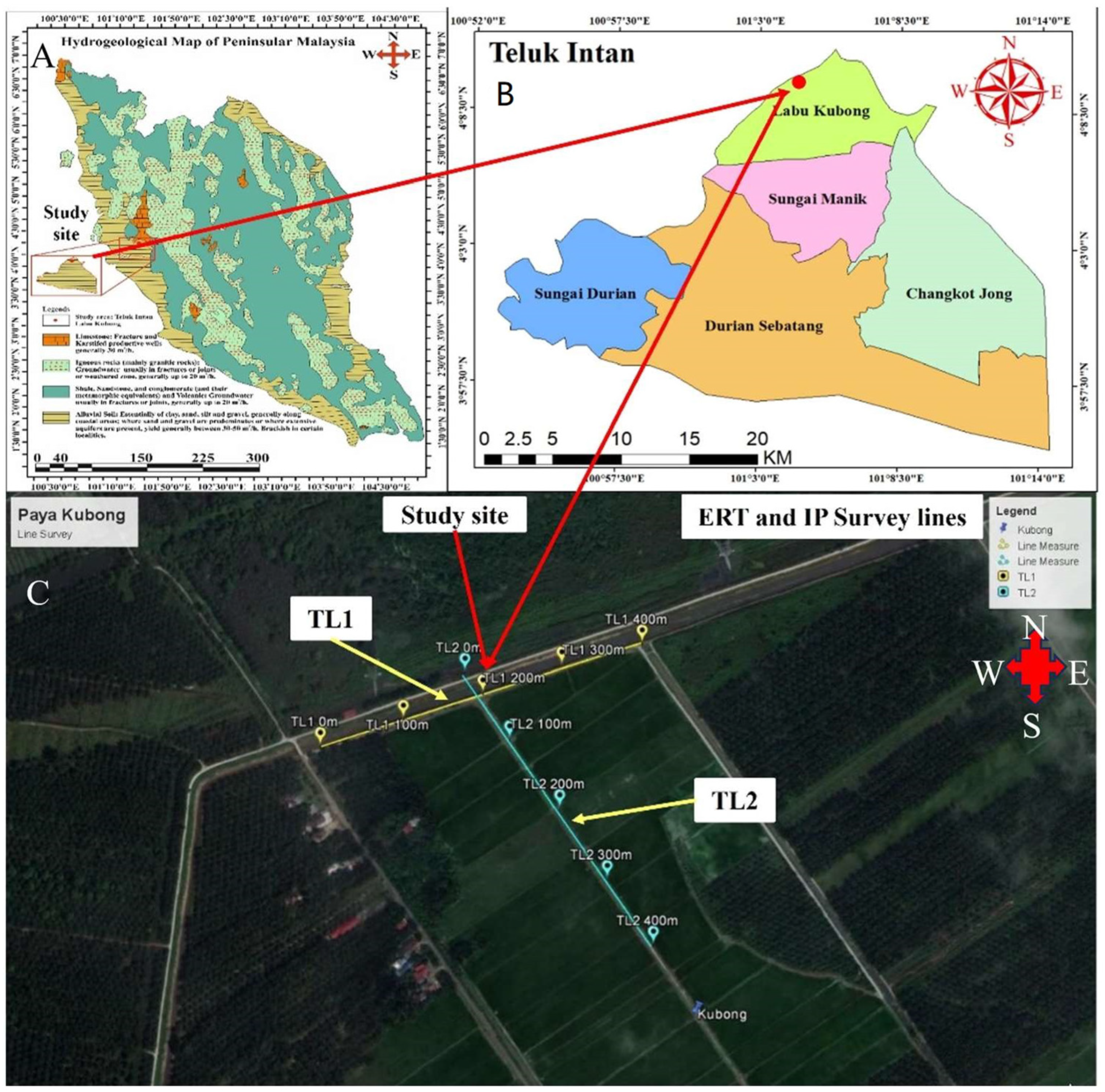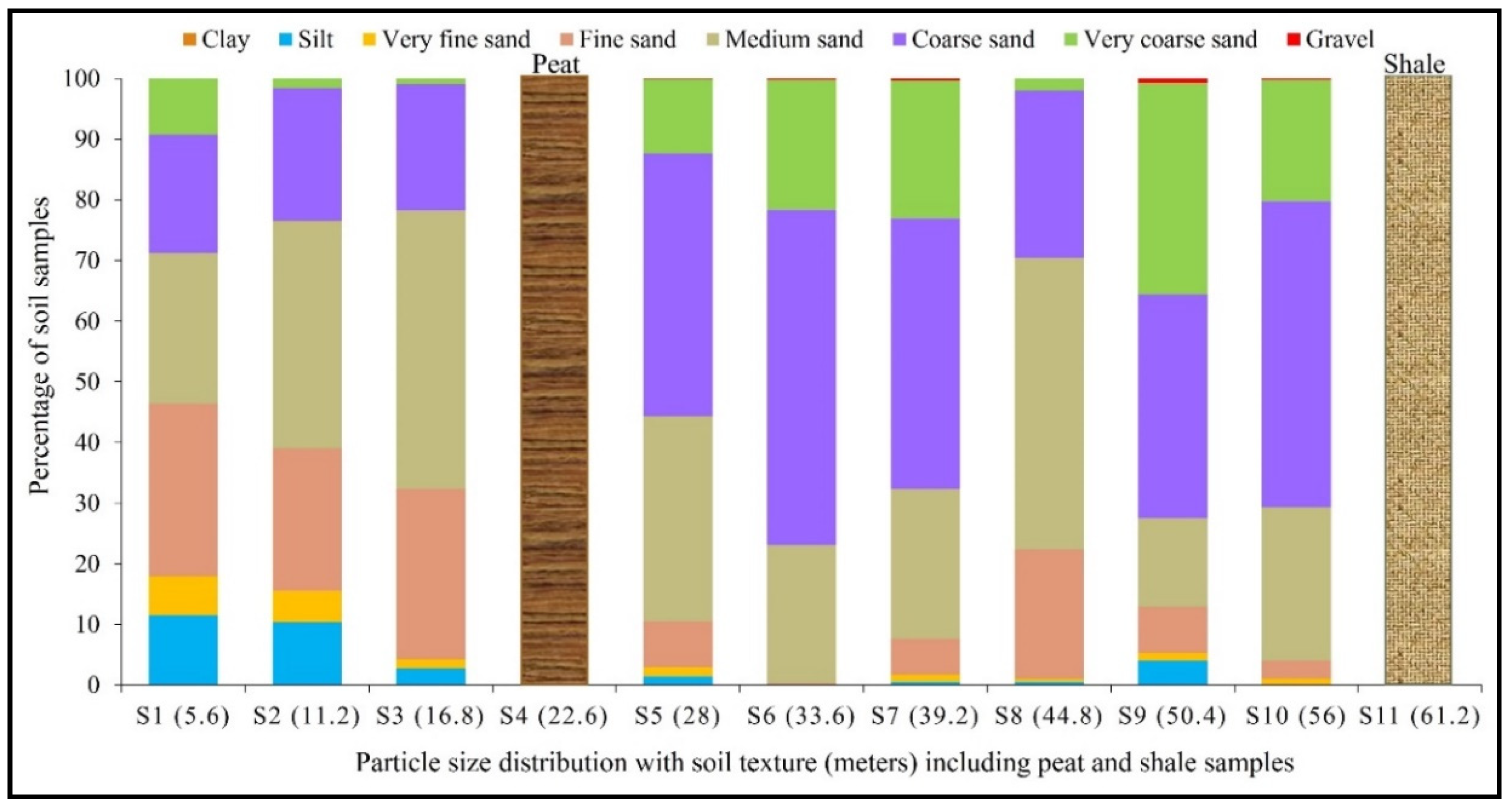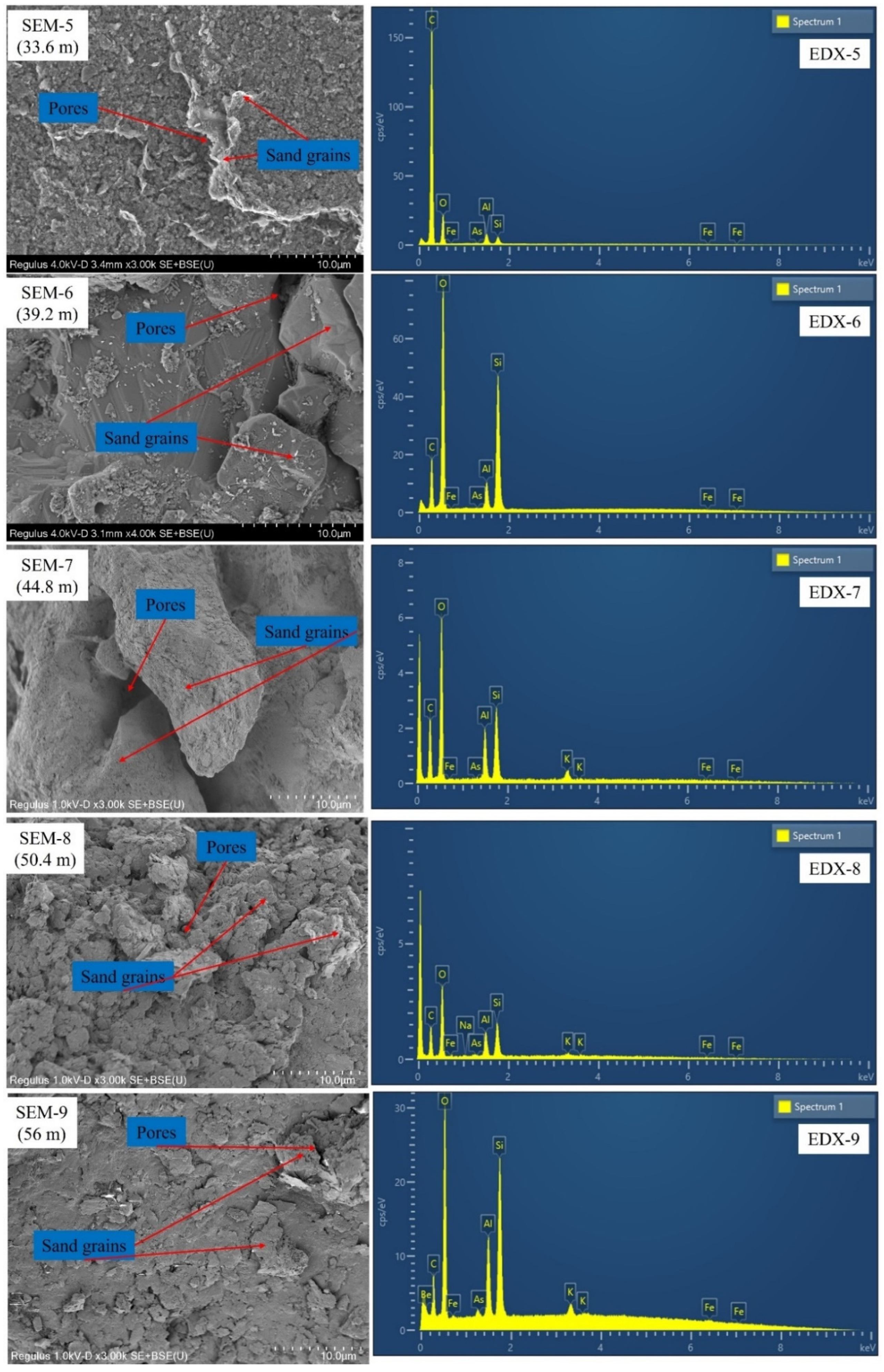Particle Size Distribution and Composition of Soil Sample Analysis in a Single Pumping Well Using a Scanning Electron Microscope Coupled with an Energy Dispersive X-ray (SEM-EDX) and the Laser Diffraction Method (LDM)
Abstract
:1. Introduction
2. Materials and Methods
2.1. Study Area
2.2. Geological and Hydrogeological Study
2.3. Previous Studies of Geophysical Surveys in the Study Area
2.4. Soil Sample Preparation and Instrument Analysis
2.5. Particle Size Distribution Using Laser Diffraction Method
2.6. Soil Elemental Analysis Using SEM-EDX Methods
3. Results and Discussions
3.1. Soil Texture Investigation
3.2. Chemical Composition of Soil Samples
4. Conclusions
Author Contributions
Funding
Data Availability Statement
Acknowledgments
Conflicts of Interest
References
- Afrin, H. Stabilization of Clayey Soils Using Chloride Components. Am. J. Civ. Eng. 2017, 5, 365–370. [Google Scholar] [CrossRef]
- Abd El-Aal, A.K.; Salah, M.K.; Khalifa, M.A. Acoustic and Strength Characterization of Upper Cretaceous Dolostones from the Bahariya Oasis, Western Desert, Egypt: The Impact of Porosity and Diagenesis. J. Pet. Sci. Eng. 2020, 187, 106798. [Google Scholar] [CrossRef]
- Asmeda, R.; Noorlaila, A.; Norziah, M.H. Relationships of Damaged Starch Granules and Particle Size Distribution with Pasting and Thermal Profiles of Milled MR263 Rice Flour. Food Chem. 2016, 191, 45–51. [Google Scholar] [CrossRef] [PubMed]
- Ho, S.Y.; Wasli, M.E.B.; Perumal, M. Evaluation of Physicochemical Properties of Sandy-Textured Soils under Smallholder Agricultural Land Use Practices in Sarawak, East Malaysia. Appl. Environ. Soil Sci. 2019, 2019, 7685451. [Google Scholar] [CrossRef]
- Polakowski, C.; Ryżak, M.; Sochan, A.; Beczek, M.; Mazur, R.; Bieganowski, A. Particle Size Distribution of Various Soil Materials Measured by Laser Diffraction—The Problem of Reproducibility. Minerals 2021, 11, 465. [Google Scholar] [CrossRef]
- Rasmin, R. Comparison between Sieve Analysis & Hydrometer with Laser Particle Analyzer to Determine Particle Size Distribution. Master’s Thesis, Universiti Malaysia Pahang, Kuantan, Malaysia, 2009. [Google Scholar]
- Moench, M.; Burke, J.; Moench, Y. Rethinking the Approach to Groundwater and Food Security; Institute for Social and Environmental Transition Boulder: Wheat Ridge, CO, USA, 2003. [Google Scholar]
- USDA. Keys to Soil Taxonomy, 12th ed.; U.S. Government Printing Office (Soil Conservation Service): Washington, DC, USA, 2014.
- VRO. Practical Note: Soil Colour; Victorian Resources Online. 2019. Available online: www.bettersoils.com.au (accessed on 2 March 2019).
- Finch, H.J.S.; Samuel, A.M.; Lane, G.P.F. Soils and Soil Management. In Lockhart & Wiseman’s Crop Husbandry Including Grassland; Elsevier: Amsterdam, The Netherlands, 2014; pp. 37–62. [Google Scholar] [CrossRef]
- Gardner, C.M.K.; Laryea, K.B.; Unger, P.W. Soil Physical Constraints to Plant Growth and Crop Production; United Nations: Rome, Italy, 1999. [Google Scholar]
- Marto, A.; Yusoff, S.Y.M. Major Soil Type, Soil Classification, and Soil Maps. In Soils of Malaysia; Ashraf, M.A., Othman, R., Ishak, C.F., Eds.; CRC Press Taylor & Francis Group: Boca Raton, FL, USA, 2018; p. 205. [Google Scholar]
- Raveendra, R.; Singh, V.P.; Upadhyay, A. Soil Analysis. In Planning and Evaluation of Irrigation Projects: Methods and Implementation; Academic Press: Cambridge, MA, USA; Elsevier: Amsterdam, The Netherlands, 2017; pp. 505–523. [Google Scholar] [CrossRef]
- Rawls, W.J.; Brakensiek, C.L.; Saxton, K.E. Estimation of Soil Water Properties. Trans.—Am. Soc. Agric. Eng. 1982, 25, 1316–1321. [Google Scholar] [CrossRef]
- Brady, N.C.; Weil, R. Elements of the Nature and Properties of Soils; Pearson Prentice Hall: Hoboken, NJ, USA, 2013. [Google Scholar]
- Jafery, K.M.; Embong, Z.; Othman, N.K.; Yaakob, N.; Shah, M.; Hashim, N.Z.N. SEM-EDX and AFM Analysis for the Surface Corrosion Morphology Structure and Roughness on Embedded X70 External Pipeline in Acidic Soil (Peat) Environment. Mater. Today Proc. 2021, 48, 1929–1935. [Google Scholar] [CrossRef]
- Buurman, P.; Pape, T.; Muggler, C.C. Laser Grain-Size Determination in Soil Genetic Studies 1. Practical Problems. Soil Sci. 1997, 162, 211–218. [Google Scholar] [CrossRef]
- Allen, T. Particle Size Analysis by Sieving. In Powder Sampling and Particle Size Determination; Elsevier: Amsterdam, The Netherlands, 2003; pp. 208–250. [Google Scholar]
- Sedláčková, K.; Ševelová, L. Comparison of Laser Diffraction Method and Hydrometer Method for Soil Particle Size Distribution Analysis. Acta Hortic. Regiotect. 2021, 24, 49–55. [Google Scholar] [CrossRef]
- Ryzak, M.; Bieganowski, A.; Walczak, R.T. Application of Laser Diffraction Method for Determination of Particle Size Distribution of Grey-Brown Podzolic Soil. Res. Agric. Eng. 2007, 53, 34–38. [Google Scholar] [CrossRef]
- Wang, W.P.; Liu, J.L.; Zhang, J.B.; Li, X.P.; Cheng, Y.N.; Xin, W.W.; Yan, Y.F. Evaluation of Laser Diffraction Analysis of Particle Size Distribution of Typical Soils in China and Comparison with the Sieve-Pipette Method. Soil Sci. 2013, 178, 194–204. [Google Scholar] [CrossRef]
- Yang, Y.; Wang, L.; Wendroth, O.; Liu, B.; Cheng, C.; Huang, T.; Shi, Y. Is the Laser Diffraction Method Reliable for Soil Particle Size Distribution Analysis? Soil Sci. Soc. Am. J. 2019, 83, 276–287. [Google Scholar] [CrossRef]
- Yahaya, S.; Jikan, S.S.; Badarulzaman, N.A.; Adamu, A.D. Chemical Composition and Particle Size Analysis of Kaolin. Path Sci. 2017, 3, 1001–1004. [Google Scholar] [CrossRef]
- Rashid, N.A.A.; Abustan, I.; Adlan, M.N. Effect of Particle Size Distribution to Remove Contaminants in Groundwater at Dengkil, Selangor. Appl. Mech. Mater. 2015, 773–774, 1158–1162. [Google Scholar] [CrossRef]
- Aweng, E.; Ismid, S.; Maketab, M.; Liyana, A.A. Sediment Size Distribution at Three Rivers with Different Types of Land Use in Endau Catchment Area, Kluang, Johor, Malaysia. J. Appl. Sci. Environ. Manag. 2016, 20, 508–511. [Google Scholar] [CrossRef]
- Rosli, N.; Saad, R.; Rahman, N.; Ismail, N.A. Soft Soils: A Study on Their Electrical Resistivity Values and Geotechnical Properties (Porosity, SPT and Particle Size Distribution). War. Geol. 2020, 46, 186–190. [Google Scholar] [CrossRef]
- Roberson, S.; Weltje, G.J. Inter-instrument Comparison of Particle-size Analysers. Sedimentology 2014, 61, 1157–1174. [Google Scholar] [CrossRef]
- Goossens, D. Techniques to Measure Grain-size Distributions of Loamy Sediments a Comparative Study of Ten Instruments for Wet Analysis. Sedimentology 2008, 55, 65–96. [Google Scholar] [CrossRef]
- Abdullah, G.M.S.; Wahhab, H.I.A. Stabilisation of Soils with Emulsified Sulphur Asphalt for Road Applications. Road Mater. Pavement Des. 2019, 20, 1228–1242. [Google Scholar] [CrossRef]
- Wong, M.K.; Selliah, P.; Ng, T.F.; Hassan, M.H.A.; Ranst, E.V.; Inubushi, K. Impact of Agricultural Land Use on Physicochemical Properties of Soils Derived from Sedimentary Rocks in Malaysia. Soil Sci. Plant Nutr. 2020, 66, 214–224. [Google Scholar] [CrossRef]
- Sujaul, I.M.; Ismail, B.S.; Tayeb, M.A.; Barzani, M.G.; Sahibin, A.R. Morphological and Physico-Chemical Characteristics of Soils in the Tasik Chini Catchment in Pahang, Malaysia. Pertanika J. Sci. Technol. 2016, 24, 71–87. [Google Scholar]
- Gasim, M.B.; Ismail, B.S.; Mir, S.I.; Rahim, S.A.; Toriman, M.E. The Physico-Chemical Properties of Four Soil Series in Tasik Chini, Pahang, Malaysia. Asian J. Earth Sci. 2011, 4, 75–84. [Google Scholar] [CrossRef]
- Philip, S.; Singh, N. Comparative Soil Analysis by Scanning Electron Microscope: A Forensic Perspective. Int. J. Emerg. Technol. 2020, 11, 915–923. [Google Scholar]
- Brodowski, S.; John, B.; Flessa, H.; Amelung, W. Aggregate-Occluded Black Carbon in Soil. Eur. J. Soil Sci. 2006, 57, 539–546. [Google Scholar] [CrossRef]
- Prakongkep, N.; Suddhiprakarn, A.; Kheoruenromne, I.; Gilkes, R.J. SEM Image Analysis for Characterization of Sand Grains in Thai Paddy Soils. Geoderma 2010, 156, 20–31. [Google Scholar] [CrossRef]
- Cengiz, S.; Karaca, A.C.; Çakir, I.; Üner, H.B.; Sevindik, A. SEM-EDS Analysis and Discrimination of Forensic Soil. Forensic Sci. Int. 2004, 141, 33–37. [Google Scholar] [CrossRef] [PubMed]
- Vos, K.; Vandenberghe, N.; Elsen, J. Surface Textural Analysis of Quartz Grains by Scanning Electron Microscopy (SEM): From Sample Preparation to Environmental Interpretation. Earth-Sci. Rev. 2014, 128, 93–104. [Google Scholar] [CrossRef]
- Kumar, R.S.; Rajkumar, P. Characterization of Minerals in Air Dust Particles in the State of Tamilnadu, India through FTIR, XRD and SEM Analyses. Infrared Phys. Technol. 2014, 67, 30–41. [Google Scholar] [CrossRef]
- Li, D.; Li, Y.; Wang, Z.; Wang, X.; Li, Y. Quantitative, SEM-Based Shape Analysis of Sediment Particles in the Yellow River. Int. J. Sediment Res. 2016, 31, 341–350. [Google Scholar] [CrossRef]
- Jamari, S.; Embong, Z.; Bakar, I. Elemental Composition Study of Heavy Metal (Ni, Cu, Zn) in Riverbank Soil by Electrokinetic-Assisted Phytoremediation Using XRF and SEM/EDX. AIP Conf. Proc. 2014, 1584, 221–227. [Google Scholar] [CrossRef]
- Jiménez-Pinilla, P.; Mataix-Solera, J.; Arcenegui, V.; Delgado, R.; Martín-García, J.M.; Lozano, E.; Martínez-Zavala, L.; Jordán, A. Advances in the Knowledge of How Heating Can Affect Aggregate Stability in Mediterranean Soils: A XDR and SEM-EDX Approach. Catena 2016, 147, 315–324. [Google Scholar] [CrossRef]
- Lešer, V.; Milani, M.; Tatti, F.; Tkalec, Ž.P.; Štrus, J.; Drobne, D. Focused Ion Beam (FIB)/Scanning Electron Microscopy (SEM) in Tissue Structural Research. Protoplasma 2010, 246, 41–48. [Google Scholar] [CrossRef]
- Metcalfe, I. Tectonic Evolution of the Malay Peninsula. J. Asian Earth Sci. 2013, 76, 195–213. [Google Scholar] [CrossRef]
- Makoundi, C.; Zaw, K.; Large, R.R.; Meffre, S.; Lai, C.K.; Hoe, T.G. Geology, Geochemistry and Metallogenesis of the Selinsing Gold Deposit, Central Malaysia. Gondwana Res. 2014, 26, 241–261. [Google Scholar] [CrossRef]
- Pour, A.B.; Hashim, M. Structural Mapping Using PALSAR Data in the Central Gold Belt, Peninsular Malaysia. Ore Geol. Rev. 2015, 64, 13–22. [Google Scholar] [CrossRef]
- Sun, C.; Yang, X.; Du, G.; Abdul Aziz, J.H. Genesis of the Selinsing Gold Deposit, Peninsular Malaysia: Constraints from Mineralogy, Geochemistry and in Situ Sulfur Isotope Compositions of Sulfides. Ore Geol. Rev. 2019, 113, 103111. [Google Scholar] [CrossRef]
- Fauzie, M.J. Evaluation of Groundwater Potential for Irrigation at the Seberang Perak Aquifer. Master’s Thesis, Universiti Putra Malaysia, Serdang, Malaysia, 2013. [Google Scholar]
- Batchelor, D.A.F. Clarification of Stratigraphic Correlation and Dating of Late Cainozoic Alluvial Units in Peninsular Malaysia. Bull. Geol. Soc. Malaysia 2015, 61, 75–84. [Google Scholar] [CrossRef]
- Hassan, K. A Summary of the Quaternary Geology Investigations in Seberang Prai, Pulau Pinang and Kuala Kurau. Bull. Geol. Soc. Malaysia 1990, 26, 47–53. [Google Scholar] [CrossRef]
- Jais, D.B.M. Hydrogeological Map of Malaysia—Present Status and Future Plan; Coordinating Committee for Geoscience Programme (CCOP) Technical Secretariat: Bangkok, Thailand, 2017. [Google Scholar]
- Chong, F.S.; Tan, D.N.K. Hydrogeological Activities in Peninsular Malaysia and Sarawak. Bull. Geol. Soc. Malays. 1986, 20, 827–842. [Google Scholar] [CrossRef]
- Akhtar, N.; Mislan, M.S.; Syakir, M.I.; Anees, M.T.; Yusuff, M.S.M. Characterization of Aquifer System Using Electrical Resistivity Tomography (ERT) and Induced Polarisation (IP) Techniques. In IOP Conference Series: Earth and Environmental Science; IOP Publishing Ltd.: Selangor, Malaysia, 2021; Volume 880, pp. 1–14. [Google Scholar]
- SSDS. Soil Survey Manual; Soil Survey Division Staff, United States Department of Agriculture, Handbook. No. 18; U.S. Govt. Print. Office: Washington, DC, USA, 1993.
- Sapari, N.; Azie, R.Z.R.; Jusoh, H. Quantity and Quality of Groundwater in Fractured Metasedimentary Rocks of the West Coast of Peninsular Malaysia. Sains Malays. 2011, 40, 537–542. [Google Scholar]
- Schwartz, F.W.; Zhang, H. Introduction to Ground Water. In Fundamentals of Groundwater; John Wiley & Sons: New York, NY, USA, 2003; p. 115. [Google Scholar]
- Scimeca, M.; Bischetti, S.; Lamsira, H.K.; Bonfiglio, R.; Bonanno, E. Energy Dispersive X-Ray (EDX) Microanalysis: A Powerful Tool in Biomedical Research and Diagnosis. Eur. J. Histochem. 2018, 62, 89–99. [Google Scholar] [CrossRef]
- Sharma, R.; Patel, K.S.; Lata, L.; Milosh, H. Characterization of Urban Soil with SEM-EDX. Am. J. Anal. Chem. 2016, 07, 724–735. [Google Scholar] [CrossRef]
- Melling, L. Peatland in Malaysia. In Tropical Peatland Ecosystems; Springer: Sarawak, Malaysia, 2015; pp. 1–651. [Google Scholar]
- Deng, J.; Ma, C.; Yu, H. Different Soil Particle-Size Classification Systems for Calculating Volume Fractal Dimension-a Case Study of Pinus Sylvestris Var. Mongolica in Mu Us Sandy Land, China. Appl. Sci. 2018, 8, 1872. [Google Scholar] [CrossRef]
- Paramanathan, S. Register of Soils—Peninsular Malaysia; Soils and Analytical Services Bulletin-Kementerian Pertanian: Kuala Lumpur, Malaysia, 1978. [Google Scholar]
- Soil Survey Staff. Keys to Soil Taxonomy, 5th ed.; United States Department of Agriculture (USDA) and Soil Management Support Services (SMSS): Blacksburg, VA, USA; Pocahontas Press: Dublin, VA, USA, 1992.
- Paramananthan, S. Soils of Malaysia: Their Characteristics and Identification, 1st ed.; Academy of Sciences Malaysia: Kuala Lumpur, Malaysia, 2000. [Google Scholar]
- Soil Survey Staff. Keys to Soil Taxonomy, 13th ed.; United States Department of Agriculture (USDA), Natural Resources Conservation Service (NRCS): Washington, DC, USA, 2022. Available online: https://directives.sc.egov.usda.gov/viewerFS.aspx?hid=21311 (accessed on 19 March 2019).
- Paramanathan, S. Selected Papers on Soil Science Problem Soil; ACT and Param Agricultural Soil Surveys: Petaling Jaya, Malaysia, 2014. [Google Scholar]
- Indraratna, B.; Balasubramaniam, A.S. Performance of Test Embankment Constructed to Failure on Soft Marine Clay. J. Geotech. Eng. 1993, 119, 1326–1329. [Google Scholar] [CrossRef]
- Hunt, N.; Gilkes, R. Farm Monitoring Handbook. In Farm Monitoring Handbook; University of Western Australia, Land Management Society, and National Dryland Salinity Program: Crawley, Australia, 1992; pp. 13–62. [Google Scholar]
- O’Green, A.T. Soil Water Dynamics. Nat. Educ. Knowl. 2013, 4, 1–9. [Google Scholar] [CrossRef]
- Haqiqi, I.; Grogan, D.; Hertel, T.; Schlenker, W. Quantifying the Impacts of Compound Extremes on Agriculture and Irrigation Water Demand. Hydrol. Earth Syst. Sci. 2021, 25, 551–564. [Google Scholar] [CrossRef]
- Suntharalingam, T. Quaternary Stratigraphy and Prospects for Placer Tin in the Taiping-Lumut Area, Perak. Bull. Geol. Soc. Malaysia 1984, 17, 9–32. [Google Scholar] [CrossRef]
- Suntharalingam, T. Studies on the Quaternary Geology of Peninsular Malaysia. Geol. Soaiety Malaysia Dep. Geol. Univ. Malay Kuala Lumpur 1984, 10, 101–136. [Google Scholar]
- Kasim, S.A.; Ismail, M.S.; Salim, A.M. Cenozoic Stratigraphy, Sedimentation and Tectonic Setting, Onshore Peninsular Malaysia: A Review. In Proceedings of the Third International Conference on Separation Technology 2020 (ICoST 2020), Johor, Malaysia, 15–16 August 2020; Advances in Engineering Research. Atlantis Press: Amsterdam, The Netherlands, 2021; Volume 200, pp. 265–280. [Google Scholar] [CrossRef]
- Torres, E.S.; Adajar, M.A.Q. Geotechnical Characterization of Alluvial Soil as an Alternative Roadway Construction Material. Int. J. Geomate 2021, 20, 125–131. [Google Scholar] [CrossRef]
- Deer, W.A.; Howie, R.A.; Zussman, J. An Introduction to the Rock-Forming Minerals, 3rd ed.; Berforts Information Press: Hertfordshire, UK, 2013. [Google Scholar] [CrossRef]
- Roslan, N. The Potential Susceptibility of Urban Hardrock Aquifers to Hydraulic and Contaminant Stresses: The Case of Shah Alam, Malaysia. Ph.D. Thesis, The University of Birmingham, Birmingham, UK, 2017. [Google Scholar]
- Li, W.; Shao, L.; Wang, Z.; Shen, R.; Yang, S.; Tang, U. Size, Composition, and Mixing State of Individual Aerosol Particles in a South China Coastal City. J. Environ. Sci. 2010, 22, 561–569. [Google Scholar] [CrossRef]
- Cong, Z.; Kang, S.; Dong, S.; Liu, X.; Qin, D. Elemental and Individual Particle Analysis of Atmospheric Aerosols from High Himalayas. Environ. Monit. Assess. 2010, 160, 323–335. [Google Scholar] [CrossRef]
- Pachauri, T.; Singla, V.; Satsangi, A.; Lakhani, A.; Kumari, K.M. SEM-EDX Characterization of Individual Coarse Particles in Agra, India. Aerosol Air Qual. Res. 2013, 13, 523–536. [Google Scholar] [CrossRef]
- Shaw, D.B.; Weaver, C.E. The Mineralogical Composition of Shales. J. sedmintary Petrol. 1965, 35, 213–222. [Google Scholar]
- Shoieb, M.A.; Sum, C.W.; Ismail, M.S.; Tsegab, H. International Journal of Advanced and Applied Sciences Geological Characteristic of the Kroh Formation in the Upper Perak Shales, Western Peninsula Malaysia. Int. J. Adv. Appl. Sci. 2019, 6, 102–106. [Google Scholar]
- Boateng, E.O.; Gebretsadikab, H.T.; Weng Sum, C.; Ben Awuah, J.; Padmanabhan, E. Mineralogical Analyses of Belata Black Shale, Perak, Peninsular Malaysia. War. Geol. 2020, 46, 12–16. [Google Scholar] [CrossRef]
- Lal, R. Carbon Management in Agricultural Soils. Mitig. Adapt. Strateg. Glob. Chang. 2007, 12, 303–322. [Google Scholar] [CrossRef]
- Schmidt, M.W.I.; Skjemstad, J.O.; Czimczik, C.I.; Prentice, K.M. Comparative Analysis of Black Carbon in Soils We Measured in Eight Soil Samples Exploiting Benzenecarboxylic Acids as Molecular Markers or Applying MAS NMR (Magic Angle. Global Biogeochem. Cycles 2001, 15, 163–167. [Google Scholar] [CrossRef]
- Spohn, M. Phosphorus and Carbon in Soil Particle Size Fractions: A Synthesis. Biogeochemistry 2020, 147, 225–242. [Google Scholar] [CrossRef]
- Yule, C.M.; Lim, Y.Y.; Lim, T.Y. Degradation of Tropical Malaysian Peatlands Decreases Levels of Phenolics in Soil and in Leaves of Macaranga Pruinosa. Front. Earth Sci. 2016, 4, 45. [Google Scholar] [CrossRef]
- Too, C.C.; Keller, A.; Sickel, W.; Lee, S.M.; Yule, C.M. Microbial Community Structure in a Malaysian Tropical Peat Swamp Forest: The Influence of Tree Species and Depth. Front. Microbiol. 2018, 9, 2859. [Google Scholar] [CrossRef]
- Dom, S.P.; Ikenaga, M.; Lau, S.Y.L.; Radu, S.; Midot, F.; Yap, M.L.; Chin, M.Y.; Lo, M.L.; Jee, M.S.; Maie, N.; et al. Linking Prokaryotic Community Composition to Carbon Biogeochemical Cycling across a Tropical Peat Dome in Sarawak, Malaysia. Sci. Rep. 2021, 11, 6416. [Google Scholar] [CrossRef] [PubMed]
- Wetlands International. A Quick Scan of Peatlands; Kleine Natuur Initiatief Projekten (KNIP): Petaling Jaya, Malaysia, 2010. [Google Scholar]
- Nuruddin, A.A.; Leng, H.M.; Basaruddin, F. Peat Moisture and Water Level Relationship in a Tropical Peat Swamp Forest. J. Appl. Sci. 2006, 6, 2517–2519. [Google Scholar]












Disclaimer/Publisher’s Note: The statements, opinions and data contained in all publications are solely those of the individual author(s) and contributor(s) and not of MDPI and/or the editor(s). MDPI and/or the editor(s) disclaim responsibility for any injury to people or property resulting from any ideas, methods, instructions or products referred to in the content. |
© 2023 by the authors. Licensee MDPI, Basel, Switzerland. This article is an open access article distributed under the terms and conditions of the Creative Commons Attribution (CC BY) license (https://creativecommons.org/licenses/by/4.0/).
Share and Cite
Akhtar, N.; Syakir, M.I.; Tweib, S.A.; Aminuddin, M.I.K.A.; Yusuff, M.S.M.; Alsabhan, A.H.; Alfaisal, F.M.; Alam, S.; Qadri, J. Particle Size Distribution and Composition of Soil Sample Analysis in a Single Pumping Well Using a Scanning Electron Microscope Coupled with an Energy Dispersive X-ray (SEM-EDX) and the Laser Diffraction Method (LDM). Water 2023, 15, 3109. https://doi.org/10.3390/w15173109
Akhtar N, Syakir MI, Tweib SA, Aminuddin MIKA, Yusuff MSM, Alsabhan AH, Alfaisal FM, Alam S, Qadri J. Particle Size Distribution and Composition of Soil Sample Analysis in a Single Pumping Well Using a Scanning Electron Microscope Coupled with an Energy Dispersive X-ray (SEM-EDX) and the Laser Diffraction Method (LDM). Water. 2023; 15(17):3109. https://doi.org/10.3390/w15173109
Chicago/Turabian StyleAkhtar, Naseem, Muhammad Izzuddin Syakir, Saleh Ali Tweib, Muhammad Irman Khalif Ahmad Aminuddin, Mohamad Shaiful Md Yusuff, Abdullah H. Alsabhan, Faisal M. Alfaisal, Shamshad Alam, and Jibran Qadri. 2023. "Particle Size Distribution and Composition of Soil Sample Analysis in a Single Pumping Well Using a Scanning Electron Microscope Coupled with an Energy Dispersive X-ray (SEM-EDX) and the Laser Diffraction Method (LDM)" Water 15, no. 17: 3109. https://doi.org/10.3390/w15173109






